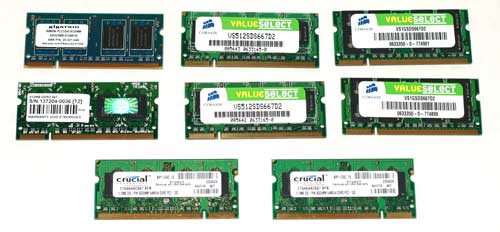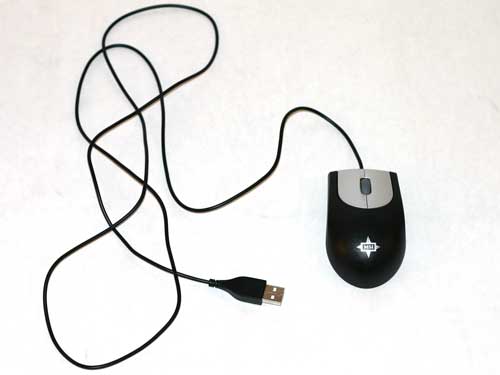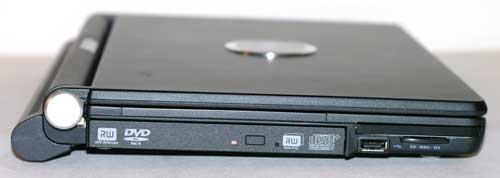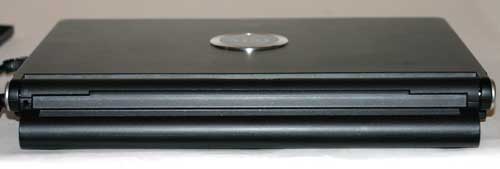MSI Megabook S271: a Look at AMD's Turion X2
by Jarred Walton on October 16, 2006 12:05 AM EST- Posted in
- Laptops
Features and Overview
The MSI S271 is definitely not a high-end laptop, even though it supports AMD's fastest Turion X2 processors. However, it is a small laptop and for those users who are more interested in size rather than high-performance features, it includes just about everything you need. The cost for the basic model including a Turion TL-50 processor (1.6 GHz, 2x256K cache), 512MB of RAM, an 80GB 5400 RPM hard drive, and a dual layer DVD-RW burner is $1000. We were initially shipped a similar configuration only with a 60GB hard drive, but we also ran tests on an upgraded version in order to investigate the Turion X2 processor performance. Here's an overview of the basic features.
Considering this is an ultraportable laptop, the feature set is basically what you would expect. It comes with a 12.1 inch widescreen display (1280x800 resolution) and weighs under 5 pounds. MSI lists the weight as 4.5 pounds for the "complete system". We checked the weight of the system alone and with the power adapter and found that their claims appear accurate: we measured 4.6 pounds for just the laptop and 5.2 pounds including the adapter and mouse (on a scale that was only accurate to 0.2 pounds, so the results are within the margin of error).
One of the major problems we have with the basic configuration is the amount of memory included. A primary reason to get a dual core processor is so that you can multitask better, right? Needless to say, better multitasking and 512MB of RAM aren't exactly a match made in heaven. Our initial testing of the platform found it to be extremely sluggish with only 512 MB of RAM -- not necessarily in actual benchmark performance, but in general use we found it to be inadequate. That's one of the problems with benchmarks: they don't always show an accurate picture of real-world use. Opening up a web browser with numerous windows/tabs along with Microsoft Word and Excel quickly uses up all of the available memory. As you begin to push the multitasking capabilities of the processor, you quickly run into a situation where the hard drive is thrashing constantly in order to keep swapping data in and out of virtual memory.
The very first recommendation we have for anyone considering this laptop (or any dual core laptop for that matter) is to get at least 1GB of memory, and if you really expect to make use of the multitasking capabilities of the dual core processor going with 2GB of RAM is a good idea, especially with Windows Vista on the horizon. We requested and received some additional memory modules from Corsair and later Crucial in order to test the system with more than 512MB of RAM, and we also requested a faster Turion X2 TL-60 processor from MSI.
Even with the upgraded processor and memory, there's still at least one area where this laptop is glaringly deficient in terms of performance. The integrated ATI Radeon Xpress 1100 graphics (roughly equivalent to the Radeon X300 SE) are at best severely underpowered. We don't have a similar laptop using Intel integrated graphics available, but we have previous results that show the ATI graphics are actually faster than most of Intel's current offerings; however, the difference between extremely sluggish 3D performance and very sluggish 3D performance isn't anything to worry about. Simply put, if you want to run any games other than solitaire, minesweeper, or other casual gaming titles, you will quickly find the included graphics to be unsatisfactory. We don't really find that to be a terrible flaw, as for business and office tasks even slow integrated graphics work fine, and you will still be able to run the Windows Vista Aero Glass interface (although performance will likely suffer compared to discrete graphics solutions).
One of the nice extras that MSI includes, even if it is a relatively inexpensive item, is a small optical mouse. It probably only costs $10 to manufacture (if that), but it's one less thing you have to worry about purchasing. We are definitely not big fans of using a trackpad if there are any other alternatives available, and although we could complain and say it's not a wireless mouse it's still better than nothing. The laptop also includes other typical features: Gigabit wired Ethernet, 802.11b/g wireless networking, AC'97 audio, and an 8-cell 4400 mAHr battery. Bluetooth networking is also supported.
In terms of expansion options, starting on the right you get two USB2.0 ports, modem and LAN ports, and a VGA output. Also on the right is the power connection and the CPU fan vent.
Moving to the left is we find an ExpressCard slot, a 4-in-1 flash card reader with support for MMC/SD/MS/MS Pro (because MS and MS Pro are totally different), a third USB2.0 port, and the optical drive.
Ending with the front of the unit, you also get the standard headphone and microphone jacks and a min-FireWire port. There are no connections on the rear of the unit.
There are certainly features that are missing relative to other laptops, but if you look at ultraportables the feature set is pretty typical. Unfortunately, cramming all of the necessary computer components into a 12"x9"x1.2" chassis requires some compromises to be made in terms of expansion options and features.
The MSI S271 is definitely not a high-end laptop, even though it supports AMD's fastest Turion X2 processors. However, it is a small laptop and for those users who are more interested in size rather than high-performance features, it includes just about everything you need. The cost for the basic model including a Turion TL-50 processor (1.6 GHz, 2x256K cache), 512MB of RAM, an 80GB 5400 RPM hard drive, and a dual layer DVD-RW burner is $1000. We were initially shipped a similar configuration only with a 60GB hard drive, but we also ran tests on an upgraded version in order to investigate the Turion X2 processor performance. Here's an overview of the basic features.
| MSI S271 Manufacturer Specifications | |
| Processor | AMD Turion 64 X2 processor TL-50 (1.60 GHz 2x256K L2) |
| Chipset | ATi RS485M + SB460 chipset |
| Graphics | UMA ATI RS485M, 128MB VRAM (ATI Xpress 1100 chipset) |
| Memory | 512MB DDR2-533 SO-DIMM memory |
| Display | 12.1" WXGA (1280x800) widescreen TFT display |
| PC Card Slot | Express Card x 1 |
| Card Reader | MMC/SD/MS/MS Pro 4-in-1 Card Reader |
| Hard Disk Drive | 80GB Hard Drive (5400RPM) |
| Optical Drive | 8X DVD+/-RW (supports DVD RAM) |
| LAN/Modem | Built-in 10/100/1000 Mbps Ethernet LAN and modem Module |
| Wireless LAN | Built-in 802.11 b/g wireless & bluetooth connection (MSI MS-6855B BT+WLAN miniPCI Combo Card with RALINK chipset) |
| I/O Ports | 15 Pin Mini D-Sub x 1 USB2.0 Port x 3, IEEE1394a Port x 1 Mic-in Port x 1, Headphone Out x 1 Modem Port x 1, LAN Port x 1 |
| Audio | Realtek ALC 882D (headphone + microphone jacks) |
| Battery | Li-ion 8 cells battery (4400mAHr) |
| AC Adapter | 19V DC, 65W/Input: 100~240V AC, 50/60Hz universal |
| Dimension | 11.93" ( W ) x 8.86" ( D ) x 1.10~1.18" ( H ) |
| Weight | < 4.5 lbs (complete system) |
| Operation System | Windows XP Home Edition |
Considering this is an ultraportable laptop, the feature set is basically what you would expect. It comes with a 12.1 inch widescreen display (1280x800 resolution) and weighs under 5 pounds. MSI lists the weight as 4.5 pounds for the "complete system". We checked the weight of the system alone and with the power adapter and found that their claims appear accurate: we measured 4.6 pounds for just the laptop and 5.2 pounds including the adapter and mouse (on a scale that was only accurate to 0.2 pounds, so the results are within the margin of error).
One of the major problems we have with the basic configuration is the amount of memory included. A primary reason to get a dual core processor is so that you can multitask better, right? Needless to say, better multitasking and 512MB of RAM aren't exactly a match made in heaven. Our initial testing of the platform found it to be extremely sluggish with only 512 MB of RAM -- not necessarily in actual benchmark performance, but in general use we found it to be inadequate. That's one of the problems with benchmarks: they don't always show an accurate picture of real-world use. Opening up a web browser with numerous windows/tabs along with Microsoft Word and Excel quickly uses up all of the available memory. As you begin to push the multitasking capabilities of the processor, you quickly run into a situation where the hard drive is thrashing constantly in order to keep swapping data in and out of virtual memory.
 |
| Click to enlarge |
The very first recommendation we have for anyone considering this laptop (or any dual core laptop for that matter) is to get at least 1GB of memory, and if you really expect to make use of the multitasking capabilities of the dual core processor going with 2GB of RAM is a good idea, especially with Windows Vista on the horizon. We requested and received some additional memory modules from Corsair and later Crucial in order to test the system with more than 512MB of RAM, and we also requested a faster Turion X2 TL-60 processor from MSI.
Even with the upgraded processor and memory, there's still at least one area where this laptop is glaringly deficient in terms of performance. The integrated ATI Radeon Xpress 1100 graphics (roughly equivalent to the Radeon X300 SE) are at best severely underpowered. We don't have a similar laptop using Intel integrated graphics available, but we have previous results that show the ATI graphics are actually faster than most of Intel's current offerings; however, the difference between extremely sluggish 3D performance and very sluggish 3D performance isn't anything to worry about. Simply put, if you want to run any games other than solitaire, minesweeper, or other casual gaming titles, you will quickly find the included graphics to be unsatisfactory. We don't really find that to be a terrible flaw, as for business and office tasks even slow integrated graphics work fine, and you will still be able to run the Windows Vista Aero Glass interface (although performance will likely suffer compared to discrete graphics solutions).
 |
| Click to enlarge |
One of the nice extras that MSI includes, even if it is a relatively inexpensive item, is a small optical mouse. It probably only costs $10 to manufacture (if that), but it's one less thing you have to worry about purchasing. We are definitely not big fans of using a trackpad if there are any other alternatives available, and although we could complain and say it's not a wireless mouse it's still better than nothing. The laptop also includes other typical features: Gigabit wired Ethernet, 802.11b/g wireless networking, AC'97 audio, and an 8-cell 4400 mAHr battery. Bluetooth networking is also supported.
 |
| Click to enlarge |
In terms of expansion options, starting on the right you get two USB2.0 ports, modem and LAN ports, and a VGA output. Also on the right is the power connection and the CPU fan vent.
 |
| Click to enlarge |
Moving to the left is we find an ExpressCard slot, a 4-in-1 flash card reader with support for MMC/SD/MS/MS Pro (because MS and MS Pro are totally different), a third USB2.0 port, and the optical drive.
 |
 |
| Click to enlarge |
Ending with the front of the unit, you also get the standard headphone and microphone jacks and a min-FireWire port. There are no connections on the rear of the unit.
There are certainly features that are missing relative to other laptops, but if you look at ultraportables the feature set is pretty typical. Unfortunately, cramming all of the necessary computer components into a 12"x9"x1.2" chassis requires some compromises to be made in terms of expansion options and features.










31 Comments
View All Comments
JarredWalton - Monday, October 16, 2006 - link
First, the "closed system" as such is not something we would recommend. Dual core with only 512MB of RAM? I already covered that. Second, the system *is* available as a barebones (MSI MS-1058), as I mentioned in the review. Memory compatibility aside, this isn't a great laptop. It's okay.The memory issues are something worth mentioning, even if we got them worked out. Even if everything had worked without issue, the laptop would have still only been okay - there are quite a few competing notebooks in the same price range, and this one fails to stand out from the crowd in any meaningful way.
Furen - Monday, October 16, 2006 - link
Sounds like you had huge memory compatibility problems, though. Personally, I always buy Crucial because when I used to buy other RAM (Kingston, etc), more often than not, I had some sort of memory compatibility problems (probably because I mixed brands but I've never had ANY problems at all with Crucial stuff).DrMrLordX - Monday, October 16, 2006 - link
I know the Core Duo is now an old product that is being replaced by the Core 2 Duo in the mobile sector, but it would have been nice to see the Turion X2 benchmarked against a Core Duo laptop as well. Surely a similarly-configured Core Duo machine exists out there somewhere.IntelUser2000 - Monday, October 16, 2006 - link
One thing is the Core 2 Duo laptop has 7200RPM HDD while the Turion X2 has 5400RPM. It shouldn't impact is greatly but it'll make a difference.IntelUser2000 - Monday, October 16, 2006 - link
Uhh. No. Clearly no. Explanation?? Turion X2 system uses integrated graphics, while Core 2 Duo system uses a powerful video card. Do you guys really think idle power of video card+chipset is equal to chipset alone??
IntelUser2000 - Monday, October 16, 2006 - link
http://www.computerbase.de/artikel/hardware/grafik...">http://www.computerbase.de/artikel/hard...hnitt_le...Integrated graphics power is clearly lower than even super low-end discrete. Now on this AT review we are talking about a mid-range part.
Sorry for triple post, but I must get my point across.
Two laptops, each possessed by one of my friends, both a Dell:
Pentium M 765 2.0GHz/533MHz FSB
1GB DDR2-533
120GB 5400RPM HDD
Geforce Go 7800GTX 128MB
15.4 inch wide-screen
70WHr battery
2.5 hour battery life with internet surfing, usage
2. Pentium M 1.6GHz/400MHz FSB/Dothan
512MB DDR2-533
Intel GMA900
60GB 4200RPM HDD
14 inch screen
45WHr battery
3.5 hour battery life with internet surfing, light usage
Is there a reason some high-end laptops are featured with integrated/discrete graphics card option?? You can turn one off?? Cause video cards in laptops suck huge amounts of power.
JarredWalton - Monday, October 16, 2006 - link
There are multiple issues involved with testing comparable laptops. Short of going out and purchasing a laptop, it's very difficult to pull off. At this point, there's not much reason to get a Core Duo notebook instead of a Core 2 Duo notebook, other than price. So we're doing our best to compare laptops that are similar, and we wanted to get this review out the door before it got any older. Obviously, we're still not recommending the MSI S271 over other laptops.In regards to Inteluser2000, he makes several comments. I have now reworded the page on power consumption to clarify a few points. However, not all of his points are entirely valid either. For example:
I don't think he was reading clearly, because I had just explained that at maximum CPU load MSI Turion X2 is consuming MORE power than ASUS Core 2 Duo. In other words, even with integrated graphics versus discrete graphics and with all of the other variables involved (7200 RPM hard drive versus 5400 RPM Drive, 14 inch LCD versus 12.1 inch LCD, etc.), without putting a load on the GPU one would expect the ASUS system to draw more power than the MSI system, and it doesn't. At idle, all of the variables can explain why the ASUS consumes more power, but when I put 100% load on just the CPU Turion X2 clearly requires more power.
I have no idea what he is trying to say with his comment about Dell laptops. Comparing a high-end system with a GeForce Go 7800 GTX to one that uses IGP is far worse than comparing something that uses GeForce Go 7700 to IGP. Different battery sizes, different display sizes, different processors, different hard drives, memory, etc. -- of course they're going to have different results. However, in this case are not drawing any final conclusions about idle power, other than to point out some interesting trends. What I am concluding is that if we were able to isolate just the CPU power use, a Turion X2 TL-60 at 100% load would require a lot more power than a Core 2 Duo T7200 at 100% load.
The ASUS system is there more as a frame of reference, particularly on the power requirements page. I really can't say for certain whether Turion X2 uses more power or less power at idle, but I am positive that it requires more power when it's placed under 100% load. Hope that explains things.
IntelUser2000 - Monday, October 16, 2006 - link
Nonono. I don't care about the load power, I care about your conclusions regarding idle. Even if you don't put load on the GPU, it consumes power. In laptop standards, lots of power. Its not a coincidence some laptop manufacturers put dual video card solutions(integrated/discrete), because they realize discrete cards affect battery life in idle, not just load. What I don't like is the explanation that its the CPU and chipset that contributes to idle power consumption and less battery life at DVD playback, Mobilemark, etc.
Check this out: http://www.trustedreviews.com/article.aspx?page=50...">http://www.trustedreviews.com/article.aspx?page=50...
(Dual GPU machine)
DVD playback
IGP: 164 minutes
Nvidia Geforce Go 6600: 112 minutes
MobileMark 2005 general battery life test
IGP:128 minutes
Geforce Go 6600: 92 minutes
30-40% battery life difference. Looks like video card is quite a big drain on battery life. I bet significant battery life difference between my friend's two system lies in the video card.
This is really a laptop review rather than a CPU review. Of course, due to laptops peculiarity of outperforming one with what looks like similar specifications, the idea of a CPU comparison on a laptop is far-fetched.
JarredWalton - Monday, October 16, 2006 - link
I did reword the rest of the page in regards to power use. I have used an ASUS W5F and found that it used about the same amount of power as the S271 (at idle). It was slightly more, so the remaining conclusions (i.e. Turion X2 in low power mode uses a bit less power) seem to be consistent. Tough to say 100% without nearly identical laptops - and you still have chipset and mobo components that can have an impact.IntelUser2000 - Monday, October 16, 2006 - link
You can find otherwise similar looking laptops that have different power consumption. How did you test out the W5F?? Just dropped in a Core 2 Duo in replacement of Core Duo?
Otherwise nice test.